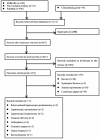The Efficacy and Safety of Knotless Barbed Sutures in the Surgical Field: A Systematic Review and Meta-analysis of Randomized Controlled Trials
- PMID: 27005688
- PMCID: PMC4804241
- DOI: 10.1038/srep23425
The Efficacy and Safety of Knotless Barbed Sutures in the Surgical Field: A Systematic Review and Meta-analysis of Randomized Controlled Trials
Abstract
The knotless barbed suture is an innovative type of suture that can accelerate the placement of sutures and eliminate knot tying. However, the outcomes of previous studies are still confounding. This study reviewed the application of different types of barbed sutures in different surgeries. We searched PubMed, EMBASE, CENTRAL and ClinicalTrials.gov to identify randomized controlled trials (RCTs) addressing the application of barbed sutures up to Feb. 2015. Two reviewers independently screened the literature and assessed the risk of bias of included studies. Then meta-analysis was performed using RevMan 5.3 software. Sensitivity analysis and subgroup analysis was performed. Seventeen RCTs (low to moderate risk of bias) involving 1992 patients were included. Compared with conventional sutures, the barbed suture could reduce suture time (SMD=-0.95, 95%CI -1.43 to -0.46, P = 0.0001) and the operative time (SMD=-0.28, 95%CI -0.46 to -0.10, P = 0.003), not significantly increase the estimated blood loss (SMD=-0.09, 95%CI -0.52 to 0.35, P = 0.70), but could lead to more postoperative complications (OR = 1.43, 95%CI 1.05 to 1.96, P = 0.03), These results varied in subgroups. Thus, barbed sutures are effective in reducing the suture and operative time, but the safety evidences are still not sufficient. It need be evaluated based on special surgeries and suture types before put into clinical practice.
Figures





Similar articles
-
Effectiveness and safety of knotless barbed sutures in cosmetic surgery: A systematic review and meta-analysis.J Plast Reconstr Aesthet Surg. 2023 Dec;87:416-429. doi: 10.1016/j.bjps.2023.10.084. Epub 2023 Oct 13. J Plast Reconstr Aesthet Surg. 2023. PMID: 37939647
-
Efficacy and safety of V-Loc™ barbed sutures versus conventional suture techniques in gynecological surgery: a systematic review and meta-analysis.Arch Gynecol Obstet. 2024 Apr;309(4):1249-1265. doi: 10.1007/s00404-023-07291-3. Epub 2023 Dec 21. Arch Gynecol Obstet. 2024. PMID: 38127141 Free PMC article.
-
Efficacy and safety of barbed suture in minimally invasive radical prostatectomy: A systematic review and meta-analysis.Kaohsiung J Med Sci. 2017 Mar;33(3):107-115. doi: 10.1016/j.kjms.2016.12.005. Epub 2017 Jan 27. Kaohsiung J Med Sci. 2017. PMID: 28254112
-
Closure methods for laparotomy incisions for preventing incisional hernias and other wound complications.Cochrane Database Syst Rev. 2017 Nov 3;11(11):CD005661. doi: 10.1002/14651858.CD005661.pub2. Cochrane Database Syst Rev. 2017. PMID: 29099149 Free PMC article.
-
Drugs for preventing postoperative nausea and vomiting in adults after general anaesthesia: a network meta-analysis.Cochrane Database Syst Rev. 2020 Oct 19;10(10):CD012859. doi: 10.1002/14651858.CD012859.pub2. Cochrane Database Syst Rev. 2020. PMID: 33075160 Free PMC article.
Cited by
-
Incidence and outcome characteristics of adverse event in surgery: an assessment based on systematic reviews of barbed suture.BMC Med Res Methodol. 2025 Jul 1;25(1):166. doi: 10.1186/s12874-025-02607-0. BMC Med Res Methodol. 2025. PMID: 40597705 Free PMC article.
-
Assessing the application of barbed sutures in comparison to conventional sutures for surgical applications: a global systematic review and meta-analysis of preclinical animal studies.Int J Surg. 2024 May 1;110(5):3060-3071. doi: 10.1097/JS9.0000000000001230. Int J Surg. 2024. PMID: 38445518 Free PMC article.
-
Anterolateral advancement pharyngoplasty versus barbed reposition pharyngoplasty in patients with obstructive sleep apnea.Eur Arch Otorhinolaryngol. 2024 Apr;281(4):1991-2000. doi: 10.1007/s00405-023-08402-1. Epub 2024 Jan 3. Eur Arch Otorhinolaryngol. 2024. PMID: 38170209 Free PMC article. Clinical Trial.
-
Postoperative small intestinal obstruction caused by barbed suture after robot-assisted laparoscopic sacrocolpopexy.IJU Case Rep. 2023 Dec 6;7(2):105-109. doi: 10.1002/iju5.12677. eCollection 2024 Mar. IJU Case Rep. 2023. PMID: 38440710 Free PMC article.
-
A Review of Barbed Sutures-Evolution, Applications and Clinical Significance.Bioengineering (Basel). 2023 Mar 27;10(4):419. doi: 10.3390/bioengineering10040419. Bioengineering (Basel). 2023. PMID: 37106607 Free PMC article. Review.
References
Publication types
MeSH terms
LinkOut - more resources
Full Text Sources
Other Literature Sources
Medical

